Biol 240 Test 2 quiz questions
1/99
Earn XP
Description and Tags
Name | Mastery | Learn | Test | Matching | Spaced |
|---|
No study sessions yet.
100 Terms
Shown is a schematic diagram of a membrane phospholipid. Which segment will always carry a negative charge?
B
Animals exploit the phospholipid asymmetry of their plasma membrane to distinguish between live cells and dead ones. When animal cells undergo a form of programmed cell death called apoptosis, phosphatidylserine—a phospholipid that is normally confined to the cytosolic monolayer of the plasma membrane—rapidly translocates to the extracellular, outer monolayer. The presence of phosphatidylserine on the cell surface serves as a signal that helps direct the rapid removal of the dead cell.
How might a cell actively engineer this phospholipid redistribution?
Choose one:
A:by inactivating both a flippase and a scramblase in the plasma membrane
B:by inverting the existing plasma membrane
C:by activating a scramblase and inactivating a flippase in the plasma membrane
D:by inactivating a scramblase in the plasma membrane
E:by boosting the activity of a flippase in the plasma membrane
C:by activating a scramblase and inactivating a flippase in the plasma membrane
In an electron transport chain, electrons are passed from one transmembrane electron carrier to another, driving proton movement across a membrane (see image below). The protons then flow through ATP synthase (not shown) to generate ATP.
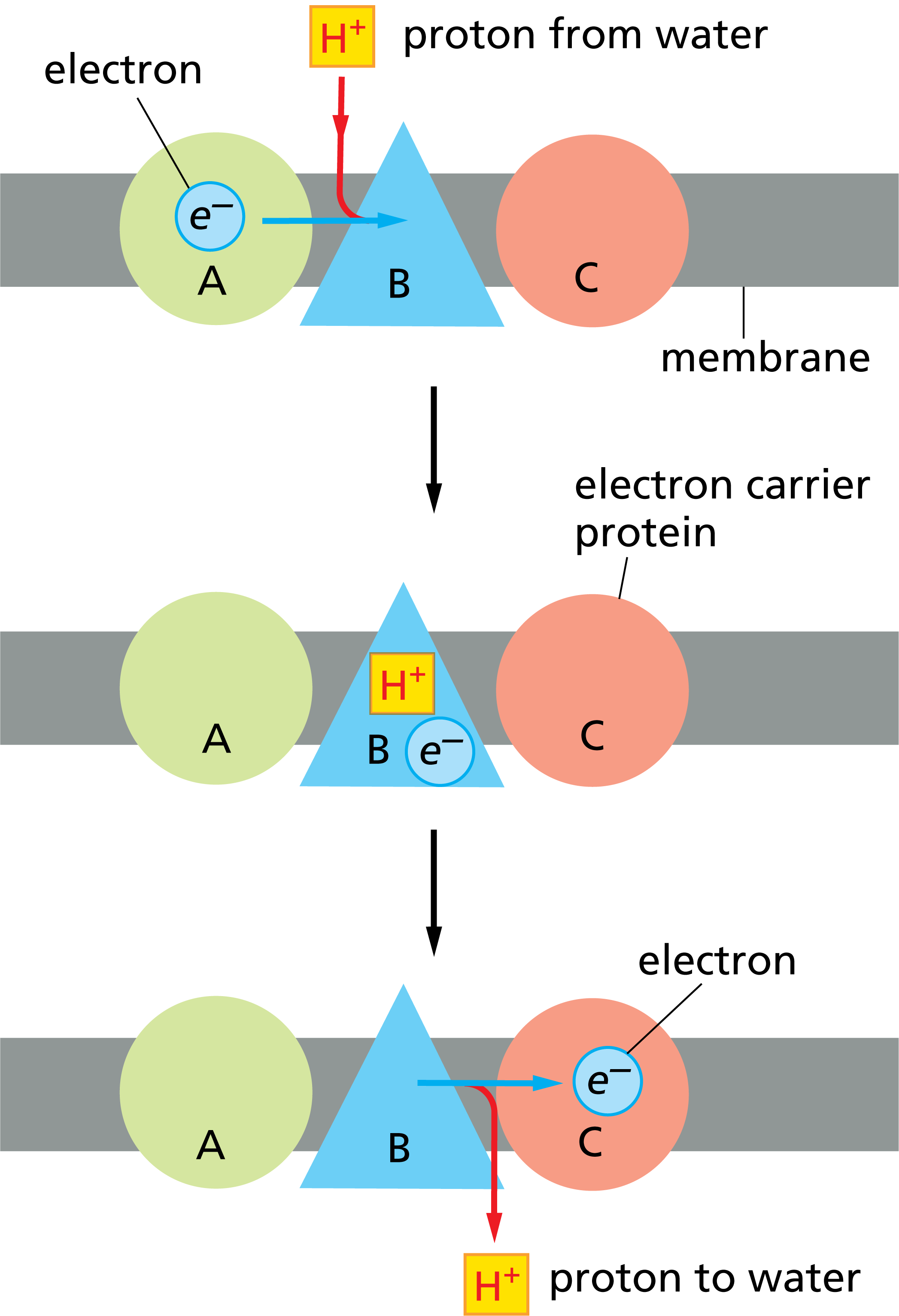
In a 2018 article (Budin, et al., Science vol. 362) researchers probed how membrane fluidity affects electron transport chain activity and ATP production in E. coli by manipulating membrane fluidity and measuring respiration. How could researchers have increased membrane fluidity?
Choose one:
A. decrease the temperature of the media the E. coli were grown in
B. increase the length of the fatty acid tails in phospholipids
C. increase the amount of cholesterol present in the bacterial membranes
D. increase the proportion of phospholipids with unsaturated fatty acids
D. increase the proportion of phospholipids with unsaturated fatty acids
Not all cellular membranes have the same relative quantity of cholesterol. Generally, the plasma membrane of animal cells contains higher amounts of cholesterol than organelle membranes such as the endoplasmic reticulum (ER) membrane. Thus, different cholesterol levels lead to different characteristics of diverse cellular membranes within the cell. Sort each of the following membrane characteristics into those more likely to apply to the ER membrane and those more likely to apply to the plasma membrane.
Categories: Plasma membrane, ER
Items: Relatively thicker membrane, increaced thermal movement, relatively stiffer membrane, relatively decreaced permeability, more water molecs found in the hydrophobic core
plasma membrane- relatively thicker membrane, relatively stiffer membrane, relatively decreaced permeability
ER-increaced thermal movement, more water molecs found in hydrophobic core
In 1925, scientists exploring how lipids are arranged within cell membranes performed a key experiment using red blood cells. Using benzene, they extracted the lipids from a purified sample of red blood cells. Because these cells have no nucleus and no internal membranes, any lipids they obtained were guaranteed to come from the plasma membrane alone.
The extracted lipids were floated on the surface of a trough filled with water, where they formed a thin film. Using a movable barrier, the researchers then pushed the lipids together until the lipids formed a continuous sheet only one molecule thick.
The researchers then made an observation that led them to conclude that the plasma membrane is a lipid bilayer.
Which of the following would have allowed the scientists to come to this conclusion?
Choose one:
A:The extracted lipids covered the same surface area as the intact red blood cells.
B:The extracted lipids covered twice the surface area of the intact red blood cells.
C:When pushed together, the extracted lipids dissolved in water.
D:The extracted lipids covered half the surface area of the intact red blood cells.
B:The extracted lipids covered twice the surface area of the intact red blood cells.
The two monolayers of the plasma membranes of eukaryotic cells are asymmetric with different membrane lipid compositions in the extracellular and cytoplasmic monolayers. Neurons contain high quantities of galactosylceramide (a glycolipid) in the extracellular monolayer. Phosphatidylethanolamine is a specific membrane phospholipid found mainly in the cytoplasmic monolayer.
How is phosphatidylethanolamine found mainly in the cytoplasmic monolayer?
Choose one:
A. A specific scramblase moves phosphatidylethanolamine to the cytoplasmic monolayer.
B. Phosphatidylethanolamine is synthesized and inserted into the lumen monolayer of the ER and then flipped to the cytoplasmic monolayer.
C. Phosphatidylethanolamine is synthesized and inserted into the cytoplasmic monolayer of the plasma membrane and is thus always in the cytoplasmic monolayer.
D. A specific flippase moves phosphatidylethanolamine to the cytoplasmic monolayer.
D. A specific flippase moves phosphatidylethanolamine to the cytoplasmic monolayer.
Naïve B cells found in our immune system each contain a specific cell-surface receptor capable of binding to a specific foreign antigen such as a protein from a pathogen like a bacterium or virus. Binding to an antigen triggers a process whereby the naïve B cell can differentiate into a plasma cell that secretes large quantities of an antibody that specifically binds to an antigen from the pathogen. Because plasma cells are long-lived cells, the immune system is then primed to rapidly respond to that antigen in the future if the person is again exposed to the pathogen. During differentiation, the cell rapidly expands the amount of endoplasmic reticulum and Golgi membranes needed for secreting the antibodies. Which organelle(s) will become particularly active in synthesizing new membrane lipids?
Choose one or more:
A. Golgi apparatus
B. Endoplasmic reticulum
C. Plasma membrane
D. Transport vesicle
B. Endoplasmic reticulum
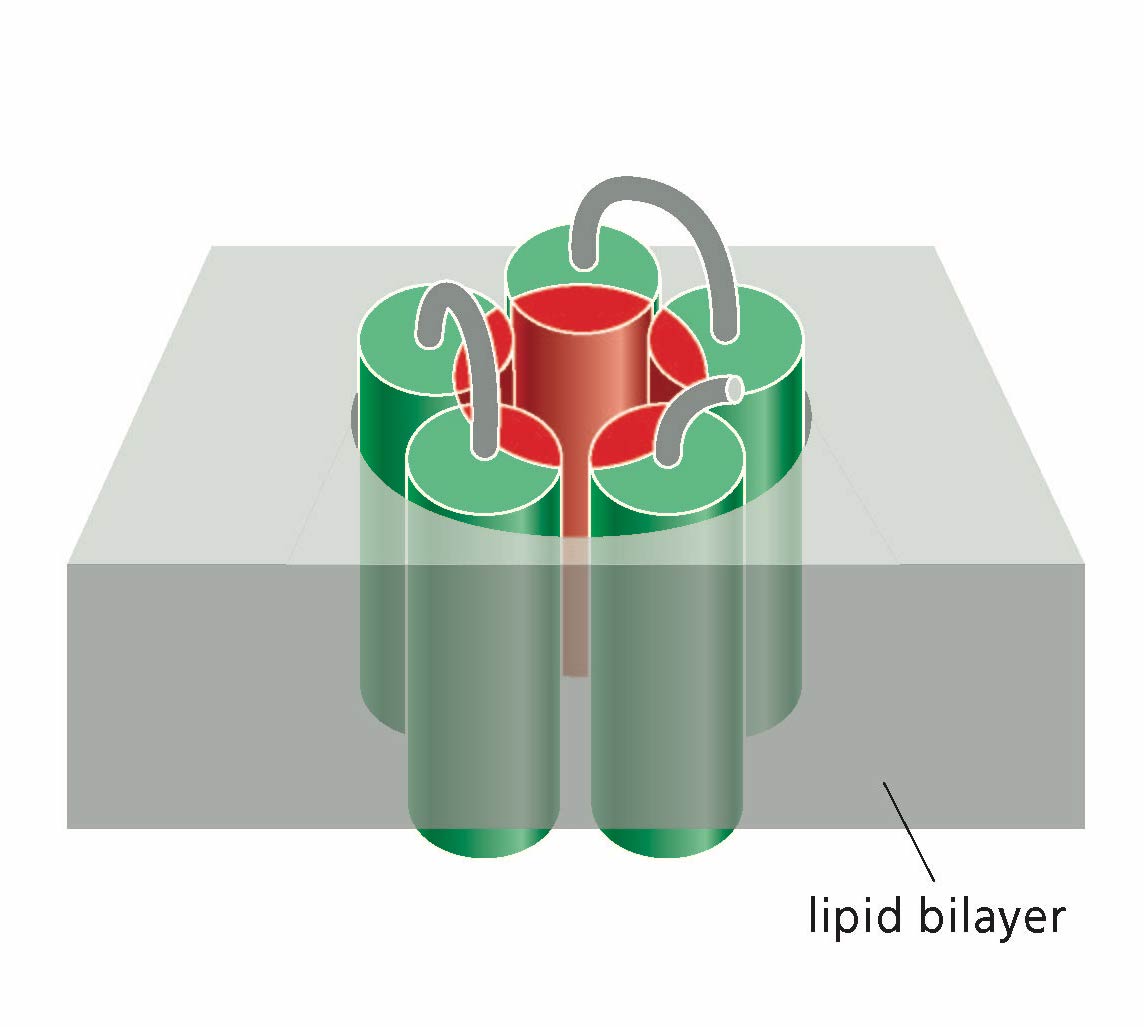
In this figure, what do the areas shown in red represent?
Choose one:
A:the amphipathic side chains of the transmembrane α helices
B:the hydrophobic side chains of the transmembrane α helices
C:the hydrophilic side chains of the transmembrane α helices
D:the hydrophobic side chains of the transmembrane β barrel
E:the hydrophobic lipid tails of the bilayer
F:the hydrophilic side chains of the transmembrane β barrel
C:the hydrophilic side chains of the transmembrane α helices
When scientists were first studying the fluidity of membranes, they did an experiment using hybrid cells. Certain membrane proteins in a human cell and a mouse cell were labeled using antibodies coupled with differently colored fluorescent tags. The two cells were then coaxed into fusing, resulting in the formation of a single, double-sized hybrid cell. Using fluorescence microscopy, the scientists then tracked the distribution of the labeled proteins in the hybrid cell.
Which best describes the results they saw and what they ultimately concluded?
Choose one:
A:Initially, the mouse and human proteins were confined to their own halves of the newly formed hybrid cell, but over time, the two sets of proteins recombined such that they all fluoresced with a single, intermediate color.
B:The mouse and human proteins began to intermix and spread across the surface of the hybrid cell, but over time, one set of proteins became dominant and the other set was lost. This suggests that cells can ingest and destroy foreign proteins.
C:Initially, the mouse and human proteins intermixed, but over time, they were able to resegregate into distinct membrane domains. This suggests that cells can restrict the movement of membrane proteins.
D:At first, the mouse and human proteins were confined to their own halves of the newly formed hybrid cell, but over time, the two sets of proteins became divided such that half faced the cytosol and half faced the hybrid cell exterior. This suggests that flippases are activated by cell fusion.
E:Initially, the mouse and human proteins were confined to their own halves of the newly formed hybrid cell, but over time, the two sets of proteins became evenly intermixed over the entire cell surface. This suggests that proteins, like lipids, can move freely within the plane of the bilayer.
F:The mouse and human proteins remained confined to the portion of the plasma membrane that derived from their original cell type. This suggests that cells can restrict the movement of their membrane proteins to establish cell-specific functional domains.
E:Initially, the mouse and human proteins were confined to their own halves of the newly formed hybrid cell, but over time, the two sets of proteins became evenly intermixed over the entire cell surface. This suggests that proteins, like lipids, can move freely within the plane of the bilayer.
Organisms that live in cold climates adapt to low temperatures by doing which of the following?
Choose one:
A:increasing the amounts of unsaturated fatty acids in their membranes to help keep their membranes fluid
B:increasing the amounts of saturated fatty acids in their membranes to help decrease the fluidity of their membranes
C:decreasing the amounts of unsaturated fatty acids in their membranes to help keep their membranes fluid
D:increasing the amounts of saturated fatty acids in their membranes to help keep their membranes fluid
E:increasing the amounts of unsaturated fatty acids in their membranes to help decrease the fluidity of their membranes
A:increasing the amounts of unsaturated fatty acids in their membranes to help keep their membranes fluid
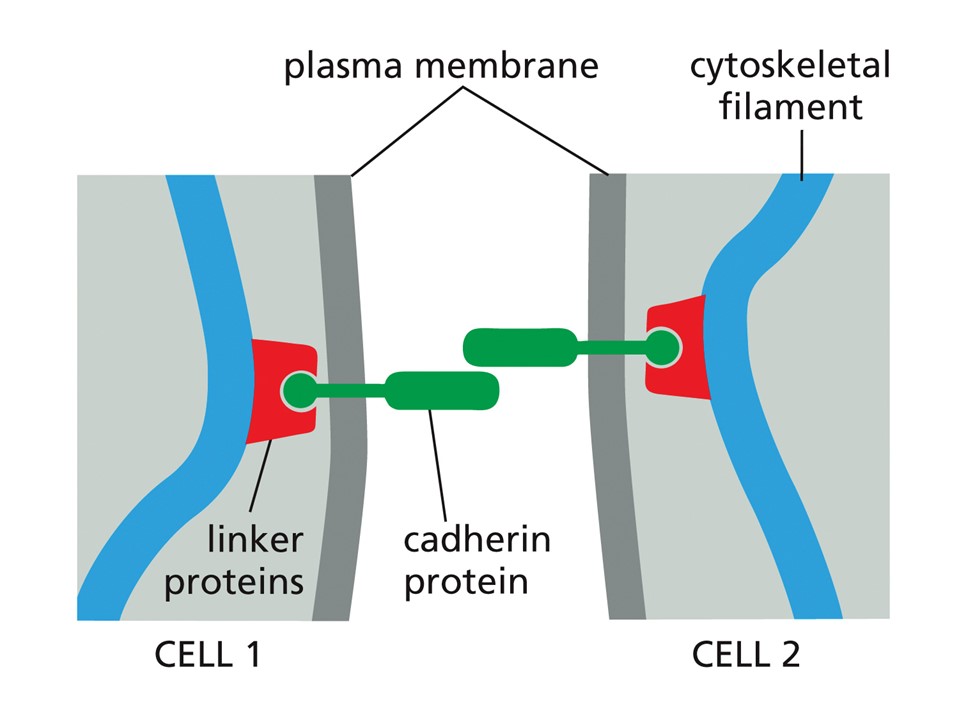
Match each of the following cadherin forms with how much it moves
Cadherin forms: Normal full-length cadherin, Cadherin deletion mutation lacking the cytoplasmic C-terminal domain, Cadherin containing several point mutations in the catenin-binding domain that decreases the binding affinity between cadherin and catenin linker proteins by 50%
Movement: A lot, a little, barely moves at all
Normal full-length cadherin: barely moves at all
Cadherin deletion mutation lacking the cytoplasmic C-terminal domain: A lot
Cadherin containing several point mutations in the catenin-binding domain that decreases the binding affinity between cadherin and catenin linker proteins by 50%: a little
The movement of an individual protein in a cell membrane can be followed using a technique called single-particle tracking (SPT).
Shown here is a diagram of the red blood cell cortex.
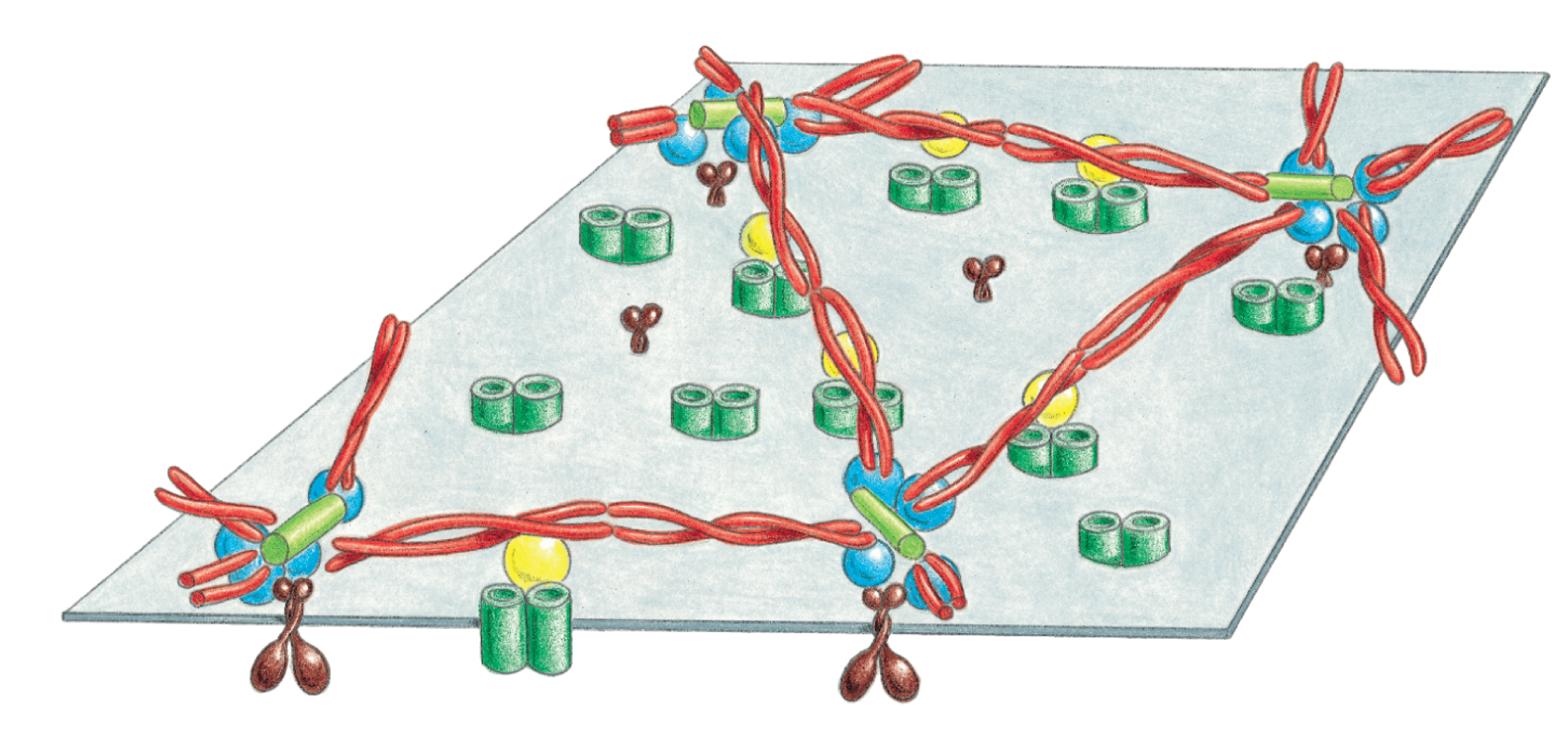
Based on this diagram, what type of movement would actin proteins that are part of the cell cortex be expected to show in an SPT study?
Choose one: A:
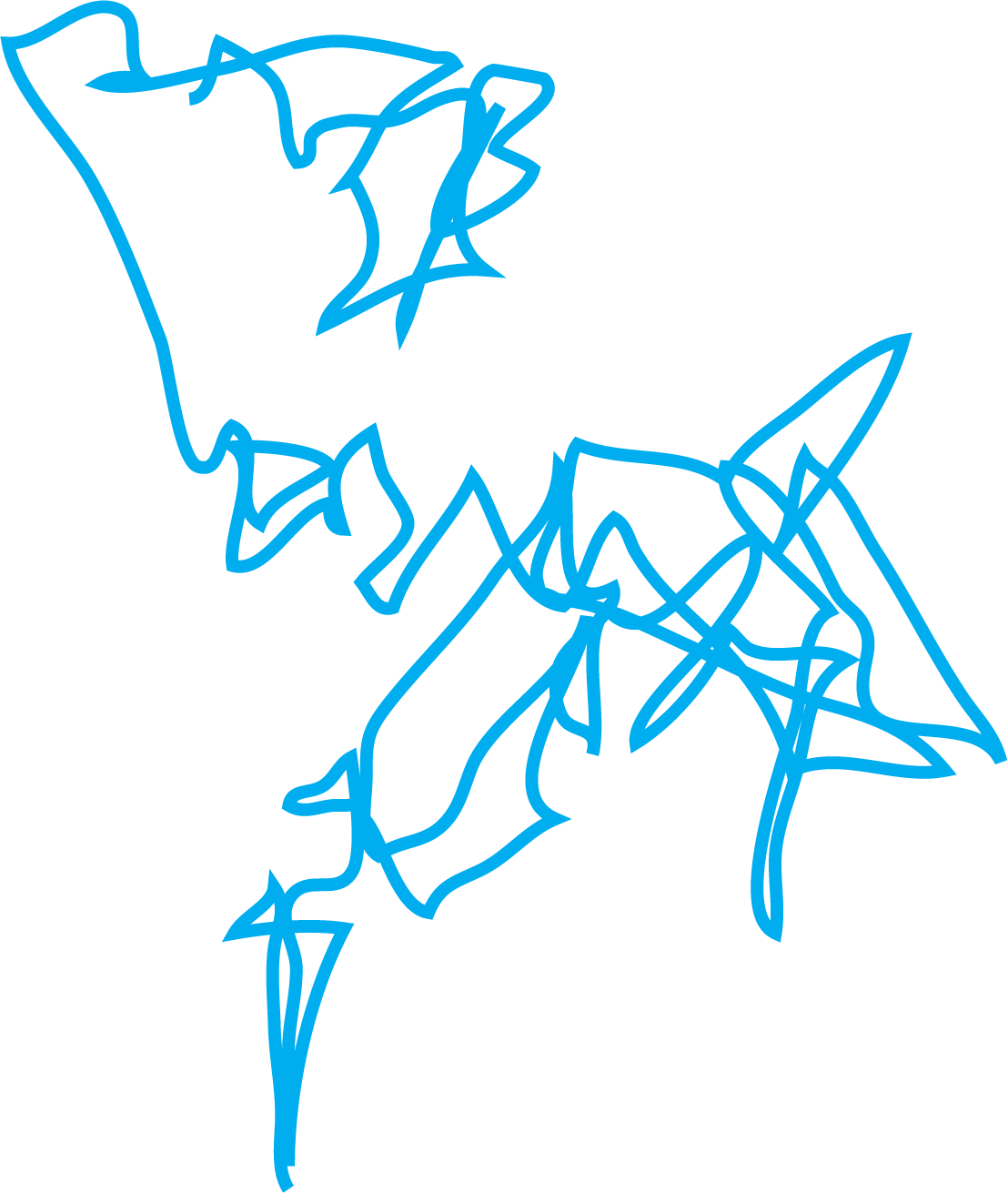
B:

C:

C
Sodium ions, oxygen (O2), and glucose pass directly through lipid bilayers at dramatically different rates. Which of the following choices presents the correct order, from fastest to slowest?
Choose one:
A. oxygen, sodium ions, glucose
B. sodium ions, oxygen, glucose
C. glucose, sodium ions, oxygen
D. glucose, oxygen, sodium ions
E. oxygen, glucose, sodium ions
E. oxygen, glucose, sodium ions
How do transporters and channels select which solutes they help move across the membrane?
Choose one:
A. Channels will allow the passage of any solute as long as it has an electrical charge; transporters bind their solutes with great specificity in the same way an enzyme binds its substrate.
B. Transporters discriminate between solutes mainly on the basis of size and electric charge; channels bind their solutes with great specificity in the same way an enzyme binds its substrate.
C. Channels allow the passage of solutes that are electrically charged; transporters facilitate the passage of molecules that are uncharged.
D. Channels discriminate between solutes mainly on the basis of size and electric charge; transporters bind their solutes with great specificity in the same way an enzyme binds its substrate.
E. Both channels and transporters discriminate between solutes mainly on the basis of size and electric charge.
D. Channels discriminate between solutes mainly on the basis of size and electric charge; transporters bind their solutes with great specificity in the same way an enzyme binds its substrate.
A group of researchers wanted to sort different white blood cell types (monocytes, lymphocytes, and granulocytes) apart from each other based on size differences and to remove unwanted contaminating red blood cells. After a particular manipulation, the red blood cells lysed. The remaining white blood cells increased in size and, more importantly, the size differences among cells increased, allowing for size-based sorting (which requires minimum size differences among cells). What manipulation did the researchers use to increase cell size?
Choose one:
A. placing cells in an environment with lower temperatures than the cells were previously exposed to
B. patch-clamp recording to monitor ion channel activity
C. placing cells in an environment with a lower solute concentration than that in the cells
D. placing cells in an environment with a higher solute concentration than that in the cells
C. placing cells in an environment with a lower solute concentration than that in the cells
The GLUT2 transporter is a passive glucose transporter found on the plasma membrane in liver cells. When blood glucose levels are high after a meal, glucose is transported by GLUT2 into liver cells for storage. When blood glucose levels are low, glucose can be transported out of the liver using the same GLUT2 transporter.
How can the same transporter transport glucose in one direction in some conditions and in the opposite direction in other conditions?
Choose one:
A. The liver cell can flip the GLUT2 transporter so glucose is transported the opposite way when needed.
B. The GLUT2 transporter transports glucose with the concentration gradient so it will transport it both into and out of the cell in the direction of the gradient.
C. The GLUT2 transporter forms a pore across the membrane for glucose to flow through.
D. The GLUT2 transporter imports glucose into the cell in a passive manner and uses the energy of ATP to export glucose.
B. The GLUT2 transporter transports glucose with the concentration gradient so it will transport it both into and out of the cell in the direction of the gradient.
Your friend is attempting to study the function of the Na+-K+ pump and has created spherical liposomes that contain only the Na+-K+ pump. She has inserted the pumps so that the extracellular side of the pump is also outside the liposome. She has added different ions and energy sources to the beaker with the liposomes, but no pumping of ions occurs. You explain that components must be in the proper location inside or outside the liposome for the pump to work. Help her by adding the proper components to the inside or outside of the liposome so that proper pumping occurs. Place unneeded components in the unneeded box.
Categories: inside the liposome, outside the liposome,uneeded
Items: K+, GTP, Na+, ATP, CL-
inside the liposome: ATP, Na+
outside the liposome: K+
uneeded: GTP, Cl-
The P-type ATPase Ca2+ pump transports Ca2+ ions into the sarcoplasmic reticulum in muscle cells in a series of steps. Put the following steps into the correct order.
1:The pump opens to the lumen side of the sarcoplasmic reticulum, releasing Ca2+
2: 2 CA2+ ions from the cytosol side bind to a pocket in the Ca2+ pump
3:ATP is hydrolyzed and a conserved aspartate group is phosphorylated
4:ADP is exchanged for a new ATP
5:2 protons bind to the pump and are exported from the sarcoplasmic reticulum
23415
Most sports drinks contain both carbohydrates and salts. The carbohydrates replace glucose burned during exercise and the salts replace salts lost in sweat. The salt also helps the small intestine absorb glucose. Pick the answer that accurately describes which salt is most beneficial for glucose absorption.
Choose one:
A. KCl, because Cl– is needed for glucose entry.
B. NaCl, because Na+ is needed for glucose entry.
C. HCl, because H+ is needed for glucose entry.
D. KCl, because K+ is needed for glucose entry.
B. NaCl, because Na+ is needed for glucose entry.
The human kidney helps control water and electrolyte balance and excretion of nitrogenous wastes. As water and solutes move through the nephron of the kidney, water is absorbed and transporters help transfer solutes in and out of the nephron. The urine is collected at the end of the nephron in a collecting duct and then transferred to the bladder. The sodium-glucose cotransporter-2 (SGLT2) is a Na+-glucose symport protein highly expressed in kidney epithelial cells lining the nephron. SGLT2 uses the Na+ gradient to transport glucose from the kidney nephron tubule into the epithelial cell cytosol. The glucose then returns to the bloodstream through passive transport out of the epithelial cells by the glucose transporter GLUT2.
Blood glucose levels are higher than normal in people with type 2 diabetes. One goal of type 2 diabetes treatment is to lower blood glucose levels. One way to do so is to keep glucose in the nephron tubule where it can be transferred to the bladder and excreted. Sort each of the following potential treatments into those that would alter kidney function to lower blood glucose levels by increasing glucose excretion and those that would increase blood glucose levels by decreasing glucose excretion.
Categories: increace exretion, decreace excretion
Items: Inhibit SGLT2 Na+-glucose symport function, Activate the Na+–K+ pump to maintain the Na+ gradient, Activate GLUT2 function, Inhibit the Na+–K+ pump to dissipate the Na+ gradient, Activate SGLT2 Na+-glucose symport function
increace secretion:Inhibit SGLT2 Na+-glucose symport function, Inhibit the Na+–K+ pump to dissipate the Na+ gradient
decrease exretion:Activate the Na+–K+ pump to maintain the Na+ gradient, Activate GLUT2 function, Activate SGLT2 Na+-glucose symport function
Many adult dogs are infected with intestinal roundworms. While many dogs do not show symptoms, puppies or severely infected adult dogs can have diarrhea, vomiting, weight loss, and other symptoms. Pyrantel is one drug used to treat roundworm infections in dogs. Pyrantel acts as an agonist (activator) of acetylcholine receptors. Activation of acetylcholine receptors causes sudden muscle contraction and paralysis of the roundworm muscles. This causes the worm to release from the dog’s intestinal wall, so the worm is passed in the dog’s stool.
Which of the following statements about pyrantel-bound acetylcholine receptors is true?
Choose one:
A. The acetylcholine receptor Na+ channel will be open less often when pyrantel is bound.
B. The acetylcholine receptor Na+ channel will be open more often when pyrantel is bound.
C. The acetylcholine receptor Na+ channel will be permanently opened by pyrantel binding.
D. The acetylcholine receptor Na+ channel will be open more narrowly when pyrantel is bound.
E. The acetylcholine receptor Na+ channel will be open wider when pyrantel is bound.
B. The acetylcholine receptor Na+ channel will be open more often when pyrantel is bound.
The Na+–Ca2+ exchanger is used to help regulate cardiac muscle function. It transports three Na+ into the cell and one Ca2+ out of the cell in every cycle. What kind of transporter is the Na+–Ca2+ exchanger?
A. Symport
B. Antiport
C. Uniport
B. Antiport
Digoxin is a drug used to treat heart failure by blocking the Na+–K+ pump in cardiac cells. How would inhibition of the Na+–K+ pump alter the intracellular concentration of Ca2+?
A. Intracellular Ca2+ levels would increase when the Na+–K+ pump is inhibited.
B. Intracellular Ca2+ would not be altered by inhibiting the Na+–K+ pump.
C. Intracellular Ca2+ levels would decrease when the Na+–K+ pump is inhibited.
A. Intracellular Ca2+ levels would increase when the Na+–K+ pump is inhibited.
Lansoprazole (prevacid) and omeprazole (prilosec) are drugs used to treat symptoms of acid reflux and gastrointestinal ulcers by lowering H+ secretion into the stomach. Both drugs inhibit the gastric H+–K+ pump. This pump is an ATPase ion pump that transports one H+ and one K+ during each cycle. The pump functions similarly to the Na+–K+ pump. Like the Na+–K+ pump, the energy of ATP is used to pump H+ and K+ ions across the plasma membrane of the parietal cells of the stomach. The pumping of H+ out of the cells into the lumen of the stomach acidifies the stomach contents.
Given that the pump is related to the Na+–K+ pump, which of the following statements would be true of the H+–K+ pump?
Choose one or more:
A. K+ is pumped into the cell.
B. ATP is hydrolyzed by the pump on the cytoplasmic side of the plasma membrane.
C. ATP causes the pump to open a channel so H+ and K+ can flow across the membrane.
D. When H+ binds to the pump, the phosphate is removed from the pump.
A. K+ is pumped into the cell.
B. ATP is hydrolyzed by the pump on the cytoplasmic side of the plasma membrane.
When a neuron is activated by a stimulus, its plasma membrane will change until it reaches a membrane potential of about +40 mV. What is special about this value?
Choose one:
A. It is the threshold potential that opens voltage-gated Na+ channels.
B. It is approximately the membrane potential at which the electrochemical gradient for K+ is zero.
C. It is the threshold potential at which voltage-gated Na+ channels close.
D. It is approximately the membrane potential at which the electrochemical gradient for Na+ is zero.
E. It is the opposite of the resting membrane potential.
D. It is approximately the membrane potential at which the electrochemical gradient for Na+ is zero.
A toxin present in scorpion venom prolongs the duration of action potentials in nerve cells. Which of these actions would best explain how this toxin exerts its effect?
Choose one:
A. It accelerates the opening of voltage-gated K+ channels.
B. It slows the inactivation of voltage-gated Na+ channels.
C. It prolongs the inactivation of voltage-gated Na+ channels.
D. It inhibits the opening of voltage-gated Na+ channels.
E. It slows the inactivation of voltage-gated K+ channels.
B. It slows the inactivation of voltage-gated Na+ channels.
Optogenetics is a powerful tool that uses light to control the activity of specific neurons. These neurons contain artificially introduced light-gated ion channels. A number of different light-gated channels with different ion specificities have been either found in nature (such as the sodium-specific channelrhodopsin, originally found in green algae) or produced via genetic engineering (the production of a chloride ion-specific form of channelrhodopsin). There are also light-gated ion channels specific for potassium or calcium. Sort each light-activated channel type based on whether activation of this channel will tend to depolarize cells or not.
categories: promote depolarization, inhibit depolarization
items: sodium channel, calcium channel, chloride channel, potassium channel
promote depolarization: sodium channel, calcium channel
inhibit depolarization: chloride channel, potassium channel
In the technique called optogenetics, light-gated Na+ channels are introduced into the brains of living animals. Activation of these channels by light can depolarize the membranes of neurons that contain them, selectively activating these target cells.
Since its inception, optogenetics has been expanded to include other types of light-gated channels, such as a channel that is selective for Cl– instead of Na+. If this light-gated Cl– channel were introduced into neurons in a region of the brain that stimulates feeding, what might you expect to see?
Choose one:
A. In response to light activation, the animals would overeat, even when they are full.
B. The animals would avoid eating, but only during the day.
C. The animals would avoid eating, even when they are hungry.
D. The channels would have no effect on behavior because the animal’s normal Na+ channels would allow normal depolarization of neurons that regulate feeding.
E. The animals would avoid eating, even when they are hungry—but only when the channels are activated by light.
E. The animals would avoid eating, even when they are hungry—but only when the channels are activated by light.
In cells that cannot carry out fermentation, which products derived from glycolysis will accumulate under anaerobic conditions?
Choose one:
pyruvate and NADH
pyruvate and NAD+
glucose and NADH
lactate and NAD+
glucose 6-phosphate and NADH
pyruvate and NADH
In substrate-level phosphorylation, a phosphate is transferred from an organic compound (the "substrate") to ADP to form ATP. Cells contain many phospho-compounds, some of which could potentially be used for substrate-level phosphorylation. Given the standard free energy of hydrolysis of ATP (–30.6 kJ/mol), which of the following molecules could serve as a phosphate donor for substrate-level phosphorylation? The standard free energy of hydrolysis for each compound is indicated in parentheses. Choose all that apply—there may be more than one correct answer.
Choose one or more:
A. 3-Phosphoglycerate (–12.5 kJ/mol)
B. Fructose-6-phosphate (–15.9 kJ/mol)
C. Creatine phosphate (–43.0 kJ/mol)
D. 1,3-Bisphosphoglycerate (–49.0 kJ/mol)
C. Creatine phosphate (–43.0 kJ/mol)
D. 1,3-Bisphosphoglycerate (–49.0 kJ/mol)
Much of what we know about metabolism comes from the use of toxins that block specific steps. Analyzing the products that accumulate in the presence of the toxin gives information about a reaction step in the pathway.
The compound fluoroacetate can enter the citric acid cycle where it is converted into an inhibitor of the enzyme aconitase. Knowing the reaction catalyzed by this enzyme (see Panel 13–2 to review), what citric acid cycle intermediate would you expect to accumulate in the presence of fluoroacetate?
Choose one:
A. Citrate
B. Oxaloacetate
C. Isocitrate
D. α-Ketoglutarate
A. Citrate
Experiments performed by Hans Krebs in the 1930s revealed that the set of reactions that oxidize food molecules and produce CO2 occur in a cycle. In one experiment, Krebs exposed pigeon muscles to malonate, a compound that inhibits succinate dehydrogenase—the enzyme that converts succinate to fumarate. Which of the following observations, made in malonate-treated muscle, led Krebs to believe that this set of reactions is cyclical?
Choose one:
If succinate were added, fumarate would accumulate.
Regardless of what he added, large amounts of oxygen would be produced.
If fumarate were added, succinate would accumulate.
Regardless of what he added, oxaloacetate would accumulate.
If citrate were added, succinate would accumulate.
If fumarate were added, succinate would accumulate.
The chemistry of many metabolic reactions was deciphered using molecules labeled with radioactive isotopes. If acetyl CoA labeled with radioactive 14C in both carbon positions were fed into the citric acid cycle, where would the radioactivity be after one turn of the cycle?
Choose one:
in CO2
in oxaloacetate
in citrate
in acetyl CoA
in oxaloacetate and in CO2
in oxaloacetate
If acetyl CoA labeled with radioactive 14C in both carbon positions were fed into the citric acid cycle, where would the radioactivity be after two turns of the cycle?
Choose one:
in oxaloacetate and in CO2
in CO2
in acetyl CoA
in oxaloacetate
in malate
in oxaloacetate and in CO2
Your friends are on a low-fat, high-carbohydrate diet, which they claim will prevent fat accumulation within their bodies. They eat tons of pasta and bread without worrying about calorie count. What can you correctly say to your friends about their potential to accumulate lipids on their low-fat diet?
Choose one:
A. They will accumulate fats because cells can convert glycolytic metabolites into lipids.
B. They will not accumulate fats because cells have no way of storing fats.
C. They will accumulate fats because cells have no way of storing carbohydrates.
D. They will not accumulate fats because carbohydrates have less energy per gram than fats.
A. They will accumulate fats because cells can convert glycolytic metabolites into lipids.
After an overnight fast, most of the acetyl CoA entering the citric acid cycle is derived from what type of molecule?
Choose one:
fatty acids
amino acids
pyruvate
glycogen
glucose
fatty acids
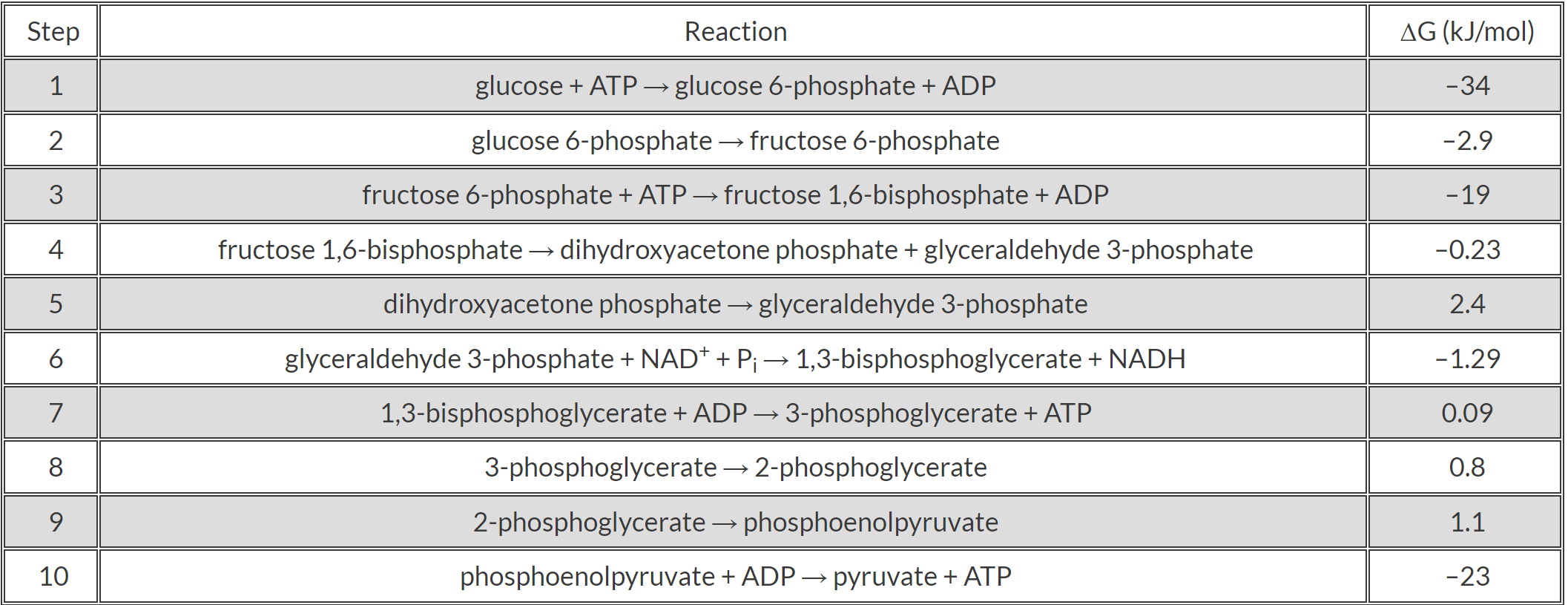
Below is a table listing the reactions that constitute the 10 steps of glycolysis, along with the change in free energy (ΔG°) for each step. Based on the data, which steps in glycolysis are effectively irreversible?
Choose one:
Steps 6 and 7
Steps 1, 3, 7, and 10
Steps 1, 3, and 10
Steps 5, 7, 8, and 9
Step 1
Steps 1, 2, 3, 4, 6, and 10
Steps 1, 3, and 10
You are packing for a hiking trip during which you’ll be burning a lot of calories with physical activity. You want to pack as efficiently as possible since you need to carry a tent and all your food. You can get the most calories out of 5kg of food if it is in the form of __
fat
In cells, pyruvate can be converted to which of the following?
Choose one or more:
glucose
acetyl CoA
oxaloacetate
lactate
alanine
glucose
acetyl CoA
oxaloacetate
lactate
alanine
Which statement is true of glycogen phosphorylase?
Choose one:
It is activated by glucose 6-phosphate and by ATP.
It is inhibited by glucose 6-phosphate and by ATP.
It stimulates gluconeogenesis.
It is activated by glucose 6-phosphate, but inhibited by ATP.
It is inhibited by glucose 6-phosphate, but activated by ATP.
It is inhibited by glucose 6-phosphate and by ATP.
Which activated carrier contains a high-energy bond whose hydrolysis releases a large amount of free energy?
Choose one:
A. glucose
B. water
C. high-energy electrons
D. ATP
E. NADH
D. ATP
Which of the following drives the production of ATP from ADP and Pi by ATP synthase?
Choose one:
phosphorylation
sunlight
a proton (H+) gradient
hydrolysis
a sodium (Na+) gradient
a proton (H+) gradient
In the electron-transport chain, as electrons move along a series of carriers, they release energy that is used to do what?
Choose one:
oxidize food molecules
pump protons across a membrane
phosphorylate ADP to form ATP
split water into protons and oxygen
hydrolyze ATP
pump protons across a membrane
Mitochondria divide by a process similar to bacterial cell fission, as shown in Figure 14–4 and animated Figure 14–4 below. However, there are some significant differences between bacterial replication and mitochondrial replication. Which of the following regulatory proteins would you expect to be involved specifically in bacterial replication only, mitochondrial replication only, or both bacterial and mitochondrial replication?
categories: bacteria only, mitochondria only, both
items: FtsZ (protein involved in constriction at the point of fission), MFN1 (a protein involved in outer membrane fusion), Single-stranded DNA binding protein (protein that binds to origin of replication and regulates DNA replication), Dam methylase (ensures only a single copy of the chromosome is made during replication)
bacteria only: Dam methylase (ensures only a single copy of the chromosome is made during replication)
mitochondria only:MFN1 (a protein involved in outer membrane fusion)
both:FtsZ (protein involved in constriction at the point of fission), Single-stranded DNA binding protein (protein that binds to origin of replication and regulates DNA replication)
Which of the following organisms have mitochondria in their cells?
Choose one or more:
bacteria
animals
plants
protozoa
yeasts
animals
plants
protozoa
yeasts
In what ways can mitochondria adapt to the changing needs of a cell?
Choose one or more:
They can change their shape.
They can change their internal structure.
They can carry out glycolysis.
They can change their number.
They can change their location.
They can change their shape.
They can change their number.
They can change their location.
Which of the following statements are true of mitochondria?
Choose one or more:
They contain an outer membrane, an inner membrane, and two internal compartments.
Inside a cell, they are mobile, constantly changing shape and position.
They contain their own DNA and RNA.
In plant cells, they are replaced by chloroplasts.
They are similar in size and shape to bacteria.
They contain an outer membrane, an inner membrane, and two internal compartments.
Inside a cell, they are mobile, constantly changing shape and position.
They contain their own DNA and RNA.
They are similar in size and shape to bacteria.
Which part of the mitochondrion contains porins?
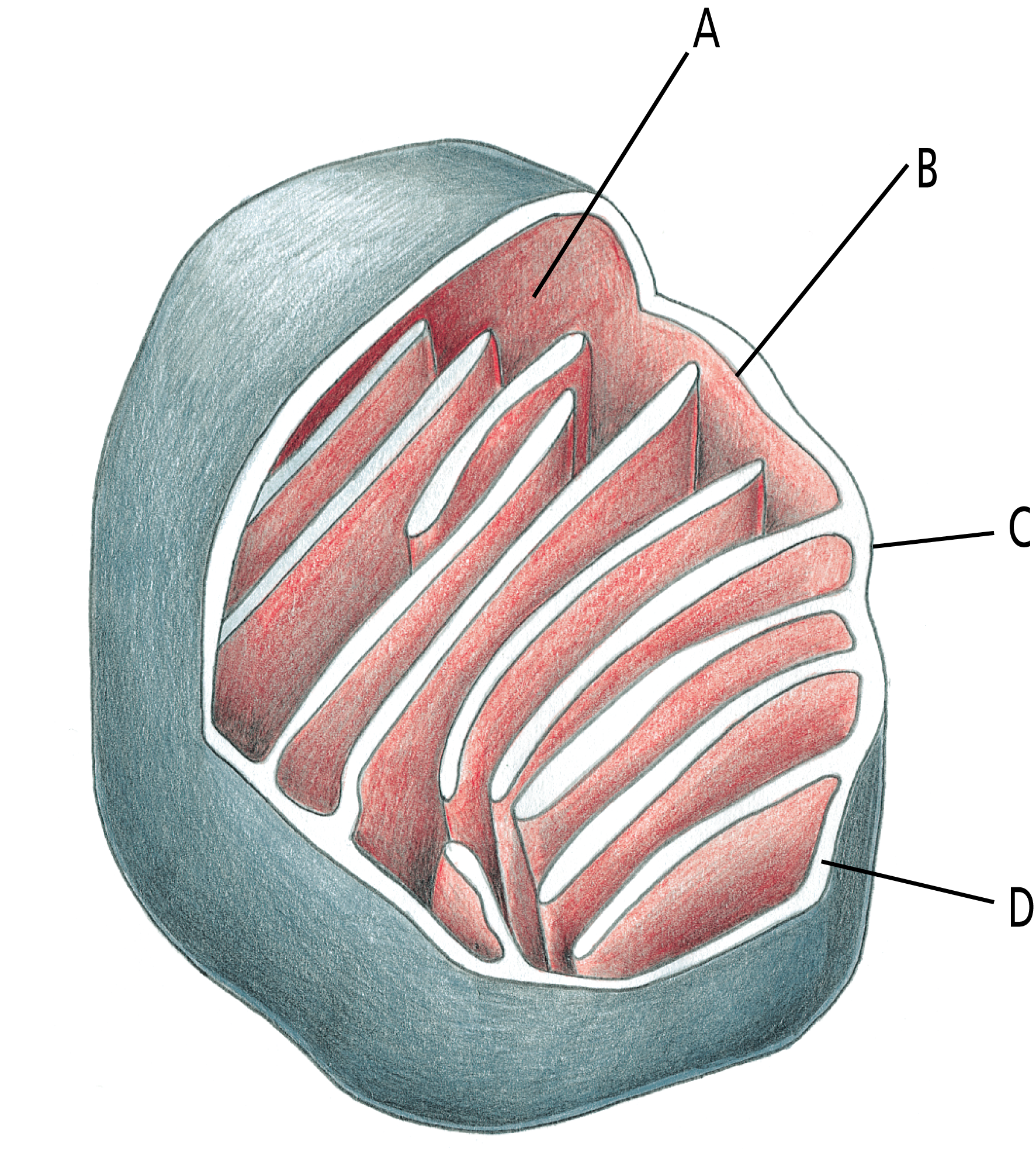
C
Which part of the mitochondrion contains the proteins that carry out oxidative phosphorylation?

B
Which part of the mitochondrion contains the enzymes needed to complete the oxidation of food-derived molecules?
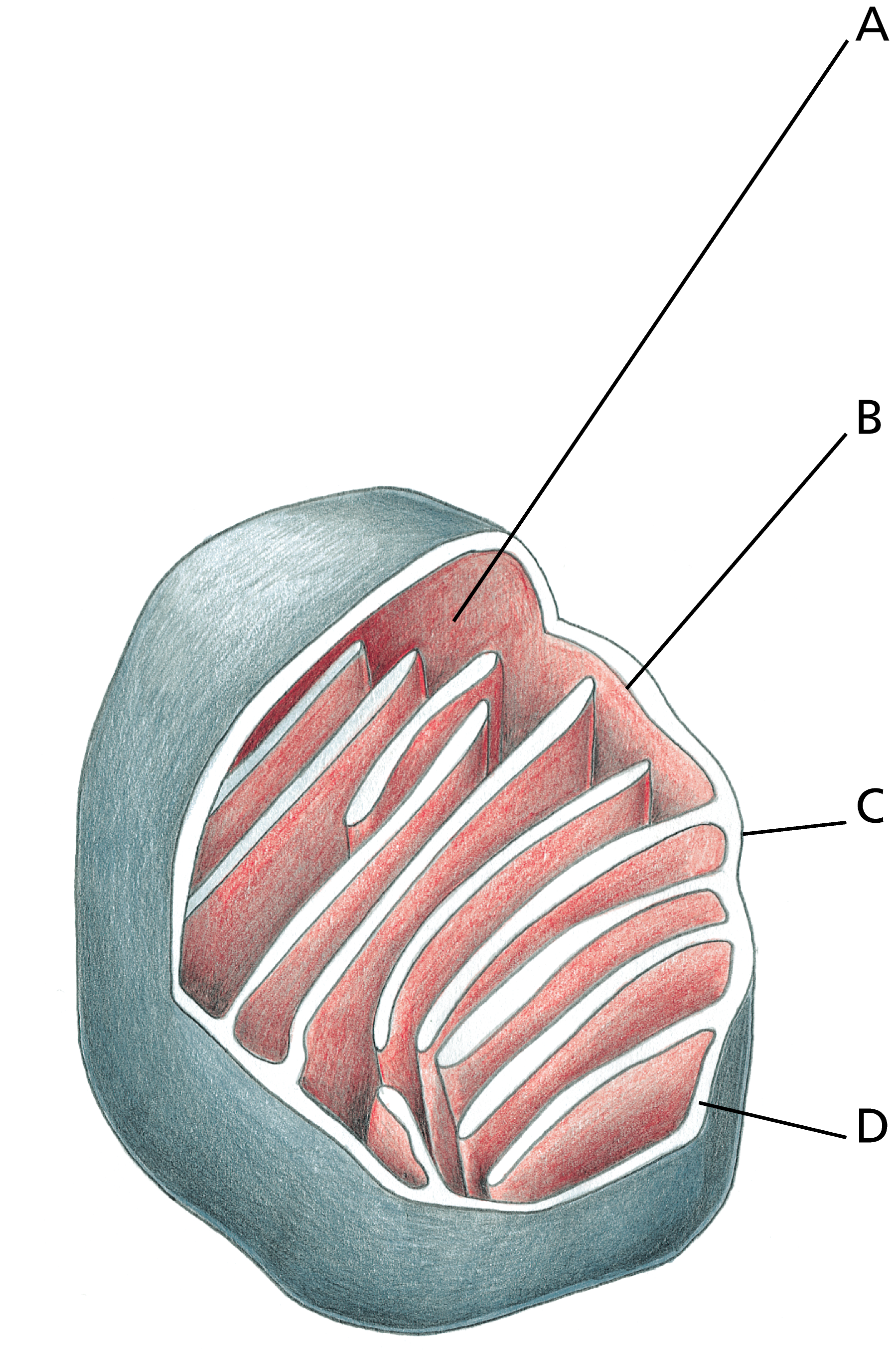
A
Which part of the mitochondrion contains the same mix of small molecules and inorganic ions as the cytosol?

D
In an animal cell, where are the proteins of the electron-transport chain located?
Choose one:
inner mitochondrial membrane
plasma membrane
ER membrane
mitochondrial matrix
outer mitochondrial membrane
inner mitochondrial membrane
Which of the following are consumed as fuel within mitochondria?
Choose one or more:
A. acetyl CoA
B. pyruvate
C. amino acids
D. fatty acids
E. glucose
A. acetyl CoA
B. pyruvate
C. amino acids
D. fatty acids
The electron-transport chain in mitochondria accepts high-energy electrons directly from which molecule?
Choose one:
acetyl CoA
H2O
NADH
ATP
pyruvate
NADH
The electron-transport chain pumps protons in which direction?
Choose one:
from the intermembrane space to the cytosol
from the matrix to the cytosol
from the cytosol to the intermembrane space
from the matrix to the intermembrane space
from the intermembrane space to the matrix
from the matrix to the intermembrane space
It is energetically favorable for protons to flow in which direction?
Choose one:
from the mitochondrial matrix to the intermembrane space
across the outer mitochondrial membrane
toward the compartment with the lowest pH
toward the compartment with the most positive charge
from the intermembrane space to the mitochondrial matrix
from the intermembrane space to the mitochondrial matrix
Which is true of ATP synthase?
Choose one:
It can break down ATP but not generate it.
It can either produce or break down ATP depending on the magnitude of the electrochemical proton gradient.
It cannot serve as a proton pump.
It is not present in plants or bacteria.
It can generate ATP but not break it down.
It can either produce or break down ATP depending on the magnitude of the electrochemical proton gradient.
What happens when ATP synthase operates “in reverse” and pumps H+ across a membrane against its electrochemical proton gradient?
Choose one:
ATP is co-transported across the membrane.
Nutrients are transported in the opposite direction across the membrane.
Na+ is transported in the opposite direction across the membrane.
ATP is hydrolyzed to form ADP and Pi.
ATP is synthesized from ADP and Pi.
ATP is hydrolyzed to form ADP and Pi.
When protons move down their electrochemical gradient into the mitochondrial matrix, what do they do?
Choose one:
produce NAD+
consume ATP
produce NADH
move electrons through the respiratory chain
produce ATP
produce ATP
Which activated carriers are produced by the citric acid cycle?
Choose one or more:
FADH2
GTP
ATP
NADPH
CO2
NADH
FADH2
GTP
NADH
The outer membrane of the nucleus is continuous with the membrane of which other organelle?
Choose one:
A. endoplasmic reticulum
B. endosome
C. peroxisome
D. Golgi apparatus
E. mitochondrion
A. endoplasmic reticulum
Which organelle is the major site of new membrane synthesis in a cell?
Choose one:
Golgi apparatus
nucleus
endoplasmic reticulum
mitochondrion
peroxisome
endoplasmic reticulum
Which organelle receives proteins and lipids from the endoplasmic reticulum, modifies them, and then dispatches them to other destinations in the cell?
Choose one:
peroxisome
endosome
Golgi apparatus
mitochondrion
nucleus
Golgi apparatus
Which organelle is essentially a small sac of digestive enzymes that functions in degrading worn-out organelles, as well as macromolecules and particles taken into the cell by endocytosis?
Choose one:
lysosome
peroxisome
nucleus
endosome
Golgi apparatus
lysosome
Which organelle sorts ingested molecules and recycles some of them back to the plasma membrane?
Choose one:
endoplasmic reticulum
lysosome
peroxisome
endosome
Golgi apparatus
endosome
Which of these strategies do prokaryotic cells use to isolate and organize their chemical reactions?
Choose one:
confining the proteins required for different metabolic processes within the plasma membrane
confining proteins required for different metabolic processes within different membrane-enclosed compartments
None; these strategies are used only by eukaryotic cells.
None; prokaryotes do not regulate their metabolic processes.
aggregating proteins into multicomponent complexes that form biochemical subcompartments with distinct functions
aggregating proteins into multicomponent complexes that form biochemical subcompartments with distinct functions
Most mitochondrial and chloroplast proteins are made within which part of the cell?
Choose one:
cytosol
peroxisome
endoplasmic reticulum
Golgi apparatus
mitochondrion or chloroplast itself
cytosol
Proteins that lack a sorting signal remain as permanent residents of which part of a eukaryotic cell?
Choose one:
Golgi apparatus
proteasome
ER
nucleus
cytosol
cytosol
If a signal sequence is removed from an ER protein, what happens to the altered protein?
Choose one:
It is escorted to the ER by chaperone proteins.
It remains in the cytosol.
It is immediately degraded.
It is unable to exit the ER.
It can enter any organelle other than the ER.
It remains in the cytosol.
What happens to proteins with no signal sequence that are made in the cytosol?
Choose one:
They are returned to their organelle of origin.
They are degraded by proteases.
They are taken up by lysosomes.
They are secreted.
They remain in the cytosol.
They remain in the cytosol.
Investigators have engineered a gene that encodes a protein bearing an ER signal sequence followed by a nuclear localization signal. What would be the likely fate of that protein?
Choose one:
Because of its conflicting signals, the protein will be degraded in the cytosol.
The protein will be recognized by a nuclear import receptor and escorted into the nucleus.
Because of its conflicting signals, the protein will remain in the cytosol.
The protein will be recognized by an SRP and enter the ER.
Because of its conflicting signals, the protein will be sent to a lysosome for destruction.
The protein will be recognized by an SRP and enter the ER.
What would happen to a protein that is engineered to contain both a nuclear localization signal and a nuclear export signal?
Choose one:
It would spend most of its time in the nucleus.
It would shuttle in and out of the nucleus.
It would bind to nuclear import receptors and nuclear export receptors, forming a nonfunctional complex.
It would be unable to fold properly and would be targeted for destruction.
It would spend most of its time in the cytosol.
It would shuttle in and out of the nucleus.
Proteins have to be unfolded to cross the membranes of which of these organelles?
Choose one or more:
mitochondria
endoplasmic reticulum
chloroplasts
nucleus
mitochondria
endoplasmic reticulum
chloroplasts
Which proteins bind to nuclear localization signals on newly synthesized proteins?
Choose one:
nuclear import receptors
nuclear export receptors
nuclear pore proteins
signal-recognition particles (SRPs)
cytosolic fibrils
nuclear import receptors
Which of these actions occur(s) commonly at a nuclear pore complex?
Choose one or more:
Protein complexes diffuse into the nucleus.
mRNA molecules are exported to the cytosol.
Small water-soluble molecules are selectively transported into the nucleus.
Proteins with a nuclear localization signal enter at the same time that proteins with a nuclear export signal exit.
Nuclear import receptors enter from the cytosol.
Nuclear import receptors are exported to the cytosol.
mRNA molecules are exported to the cytosol.
Proteins with a nuclear localization signal enter at the same time that proteins with a nuclear export signal exit.
Nuclear import receptors enter from the cytosol.
Nuclear import receptors are exported to the cytosol.
Proteins destined for the Golgi apparatus, endosomes, lysosomes, and even the cell surface must pass through which organelle?
Choose one:
ER
mitochondrion
nucleus
peroxisome
ER
Which is true of ribosomes?
Choose one:
All ribosomes are attached to the ER when they begin synthesizing a protein.
A special class of ribosomes attached to the ER membrane translates the proteins destined for that organelle.
Polyribosomes translate only cytosolic proteins.
A common pool of ribosomes is used to synthesize both cytosolic proteins and proteins destined for the ER.
Polyribosomes translate only those proteins that have an ER signal sequence.
A common pool of ribosomes is used to synthesize both cytosolic proteins and proteins destined for the ER.
As a polypeptide is being translocated across the membrane of the endoplasmic reticulum, a stop-transfer sequence can halt the process. What eventually becomes of this stop-transfer sequence?
Choose one:
It stops protein synthesis and causes the ribosome to be released back to the cytosol.
It remains in the cytosol.
It is translocated into the lumen of the endoplasmic reticulum.
It is cleaved from the protein.
It forms an α-helical membrane-spanning segment of the protein.
It forms an α-helical membrane-spanning segment of the protein.
The ER signal sequence on a growing polypeptide chain is recognized by a signal-recognition particle (SRP) in the cytosol. What does this interaction accomplish?
Choose one:
It guides the ribosome and its polypeptide to the ER.
It cleaves the ER signal sequence from the polypeptide chain.
It returns the ribosome to the pool of free ribosomes in the cytosol.
It speeds the synthesis of the polypeptide chain.
It releases the polypeptide chain from the ribosome.
It guides the ribosome and its polypeptide to the ER.
Nuclear import is driven by the hydrolysis of GTP, which is triggered by an accessory protein called Ran-GAP (GTPase-activating protein). Which is true of this process?
Choose one:
Nuclear receptors carry Ran-GTP from the nucleus to the cytosol.
Ran-GAP is present exclusively in the nucleus.
Nuclear import receptors have the ability to catalyze hydrolysis of GTP.
Ran-GTP is present in high concentrations in the cytosol.
Ran-GDP displaces proteins from nuclear import receptors inside the nucleus.
Nuclear receptors carry Ran-GTP from the nucleus to the cytosol.
The movement of materials from the plasma membrane, through endosomes, and then to lysosomes describes which type of pathway?
Choose one:
endocytic pathway
exocytic pathway
endolytic pathway
endosomal pathway
secretory pathway
endocytic pathway
What protein can assemble into a basketlike network that gives budding vesicles their shape?
Choose one:
Rab protein
SNARE
adaptin
clathrin
dynamin
clathrin
Vesicle budding is driven by which of the following?
Choose one:
hydrolysis of ATP by dynamins
capture of Rabs by tethering proteins
binding of a cargo molecule
assembly of a protein coat
interactions of v- and t-SNAREs
assembly of a protein coat
Which proteins play a central role in the fusion of a vesicle with a target membrane?
Choose one:
SNAREs
Rab proteins
tethering proteins
adaptin
clathrin
SNAREs
Which molecule is displaced when a vesicle and its target membrane fuse?
Choose one:
phospholipids
water
SNAREs
tethering proteins
clathrin
water
Where in the cell are some proteins initially decorated with an oligosaccharide tree on asparagine residues?
Choose one:
ER
peroxisome
nucleus
cytosol
Golgi apparatus
ER
Which of the following is a role of the oligosaccharides on glycosylated proteins?
Choose one or more:
A. providing a source of energy for the cell
B. promoting cell–cell recognition
C. forming part of the cell’s glycocalyx, or carbohydrate layer
D. serving as a transport signal for packaging the protein into appropriate transport vesicles
E. acting as a signal sequence for proteins destined to remain in the cytosol
F. protecting the protein from degradation and holding it in the ER until it is properly folded
B. promoting cell–cell recognition
C. forming part of the cell’s glycocalyx, or carbohydrate layer
D. serving as a transport signal for packaging the protein into appropriate transport vesicles
F. protecting the protein from degradation and holding it in the ER until it is properly folded
Through which of the following do proteins travel from one cisterna to the next in the Golgi apparatus?
Choose one:
transport vesicles that bud from one cisterna and fuse with the next
pores in the cisternal membranes
transporters in the cisternal membranes
bridges that link the cisternae
membranes via osmosis
transport vesicles that bud from one cisterna and fuse with the next
Proteins entering the cis Golgi network can do which of the following?
Choose one:
They can be held in the cis Golgi while they are properly folded and assembled.
They can either move onward through the Golgi stack or be returned to the ER.
They are sorted according to whether they are destined for lysosomes or for the cell surface.
They can either move backward to the trans Golgi network or be sent forward to the plasma membrane.
They are either sent to the nucleus or to the plasma membrane for secretion.
They can either move onward through the Golgi stack or be returned to the ER.
Which is true of the constitutive exocytosis pathway?
Choose one:
It packages proteins in secretory vesicles that accumulate near the plasma membrane.
It packages proteins that form aggregates in the conditions present in the trans Golgi.
It operates continually in all eukaryotic cells.
It replaces the regulated exocytosis pathway in cells specialized for secretion.
It packages proteins that carry a signal sequence that marks them for secretion.
It operates continually in all eukaryotic cells.
What distinguishes proteins destined for regulated secretion?
Choose one:
Their surface properties allow them to form aggregates that are packaged into secretory vesicles.
They are cleaved from membrane domains in the Golgi apparatus prior to being packed into secretory vesicles.
They are produced in small amounts and then concentrated in secretory vesicles.
They bind to clathrin in order to interact directly with the proteins to be packed into secretory vesicles.
They have a series of amino acids that act as a tag that marks them for packaging into secretory vesicles.
Their surface properties allow them to form aggregates that are packaged into secretory vesicles.
In the unfolded protein response, the accumulation of misfolded proteins in the ER serves as a signal for the cell to do which of the following?
Choose one:
produce more ER
destroy the misfolded proteins
send the misfolded proteins to the Golgi apparatus for modification and folding
glycosylate the misfolded protein
export the misfolded proteins to the cytosol
produce more ER
Which best describes a pathway that a protein might follow from synthesis to secretion?
Choose one:
ER → Golgi apparatus → secretory vesicle → plasma membrane
Cytosol → ER → Golgi apparatus → transport vesicle → endosome → secretory vesicle → plasma membrane
ER → Golgi apparatus → transport vesicle → endosome → secretory vesicle → plasma membrane
Cytosol → ER → secretory vesicle → plasma membrane
Cytosol → ER → transport vesicle → Golgi apparatus → transport vesicle → plasma membrane
Cytosol → ER → transport vesicle → Golgi apparatus → transport vesicle → plasma membrane
What is true about the structure of the Golgi apparatus?
Choose one:
It is continuous with the outer nuclear membrane.
It contains an inner membrane that is folded into cristae.
It is widely distributed throughout the cytosol.
It is an extension of the endoplasmic reticulum.
It is a flattened set of membrane-enclosed sacs usually found near the nucleus.
It is a flattened set of membrane-enclosed sacs usually found near the nucleus.
Oligosaccharide chains added in the ER can undergo further modification in which organelle(s)?
Choose one:
only the cis Golgi network
both the cis and trans Golgi networks
endosomes
lysosomes
only the trans Golgi network
both the cis and trans Golgi networks
Phagocytosis is a process by which cells do which of the following?
Choose one:
digest their own worn-out organelles
ingest extracellular fluid and macromolecules
consume large particles, such as microbes and cell debris
secrete hormones and neurotransmitters
engage in receptor-mediated endocytosis
consume large particles, such as microbes and cell debris
What happens to the final products of the digestion of macromolecules?
Choose one:
They are transferred to the cytosol through transporters in the lysosomal membrane.
They are expelled from the lysosome by H+ pumps in the lysosomal membrane.
They are removed from the lysosome by transport vesicles that carry them to where they are needed.
They are secreted from the cell when lysosomes fuse with the plasma membrane.
They are ultimately destroyed by lysosomal enzymes.
They are transferred to the cytosol through transporters in the lysosomal membrane.
Which of the following is true of lysosomes?
Choose one:
Lysosomes contain around 40 types of hydrolytic enzymes, which are optimally active at pH 7.2.
Most of the lysosomal membrane proteins have glycosylated regions on the cytosolic side of the membrane.
An ATP-driven H+ pump in the lysosomal membrane maintains the organelle's pH.
Lysosomes have a pH that is higher than that of the cytosol.
The products of digestion in lysosomes leave the lysosome by transport vesicles.
An ATP-driven H+ pump in the lysosomal membrane maintains the organelle's pH.
Which statement about receptor-mediated endocytosis of LDL particles is true?
Choose one:
LDL receptors are normally degraded in the lysosome along with LDL.
Mutations that impair the endocytosis of LDL receptors cause a drop in blood cholesterol levels.
LDL receptors in the plasma membrane associate with clathrin-coated pits.
LDL receptors are not taken up by receptor-mediated endocytosis unless they are carrying LDL.
The high pH inside endosomes allows LDL to dissociate from its receptor.
LDL receptors in the plasma membrane associate with clathrin-coated pits.
The low pH inside endosomes leads to what outcome?
Choose one:
destroying most internalized receptors
destroying all internalized cargo proteins
causing many internalized receptors to release their cargo
causing all cargo proteins to bind to their receptors
causing many internalized receptors to release their cargo